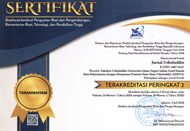The Issue of Unveiling the Aurah for Women in Quran. A Critical and Contextual Analysis of Surah al-Nūr [24]: 58-61)
Abstract
Keywords
Full Text:
PDFReferences
Albani, Nashruddin Al-. Jilbab Wanita Muslimah. terj. Hidayati. Yogyakarta: Media Hidayah, 2002.
Amrullah,Abdulmalik Abdulkarim. Tafsir al-Azhar, jilid 7. Singapura: Pustaka Nasional, 1989.
Ardiansyah. “Konsep Aurat Menurut Ulama Klasik dan Kontemporer; suatu perbandingan pengertian dan batasannya di dalam dan luar sholat”, dalam Analytica Islamica, Vol. 3, No. 2 (2014): 42-62.
Auda, Jasser. Maqāsīd al-Syari’ah as Philosophy of Islamic Law a System Approach. London: Internasional Institute of Islamic Thought, 2007.
Awa, Salwa MS. El-. Textual Relations in the Qur’an; Relevance, Coherence, and Structure. London and New York: Routledge, 2006.
Bantani, Muḥammad Nawāwī al-. Tafsīr Marāḥ Labīd. Jilid 2. Indonesia:Ḥaramaian, 2014.
Dimyati, Sayyid Muhammad ad-. Hasyiyah I’anatut Thalibin. Vol. 1. Bandung: al-Ma’arif.
Droogsma, Rachel Anderson. “Redefining Hijab: American Muslim Women’s standpoints on veiling”, in Journal of Applied Communication Research, Vol. 35, No. 3 (2007): 20-42.
Ibn Jarir at-Thabari, Jamīʻul bayān ʻan Ta’wīl al-Qur’ān. Vol. 5. Beirut: Muassasah ar-Risalah.
Katsir. Ismail bin Umar bin. Tafsīr al-Qur’ānul ʻAẓīm. Beirut: Dar ibn Hazm, 2000.
Ma’luf,Luis. Muʻjam al-Munjīd. Libanon: Darul Fikri.
Mandzur, Ibn. Lisānul ʻArab. Kairo: Darul Ma’arif, 1119.
Madkur, Ibrahim. Mu’jām Alfāz Al-Qur’ān al-Karīm. Kairo: Ihyā’a at-Turāṣ, 1988.
Mannan, Abdul. Fiqih Lintas Madzhab. jilid 1. Kediri: PP. Al-Falah, 2009.
Marhumah, Ema. “Jilbab dalam Hadis: Menelusuri Makna Profetik dari Hadis” dalam Jurnal Musāwa, Vol. 13, No. 1(2014): 30-55.
Munawwir,A. W. Kamus al-Muanawwir Arab Indonesia Terlengkap. Surabaya:Pustaka Progressif, 1997.
Nuraini dan Dhiyauddin. Islam dan Batas Aurat Wanita. Yogyakarta: Kaukaba, 2013.
Nurul Hikmah binti Nidzam. al-aurah fi fiqhi al-Islami wa atsaruha fil hayātid diniyyah wal ijtimaiyyah, in dissertation of University Islam Sultan Sharif Ali, published at faculty of syari’ah and Islamic law, 2020.
Oktariyadi. “Batasan aurat wanita dalam perspektif hukum Islam”, dalam Jurnal Al-Mursalah, Vol. 2, No, 1(2016): 60-65.
Penerbit Kalim. Al-Qur’an Tafsir Per Kata Tajwid dan Kode Angka Al-Hidayah. Tangerang Selatan: Kalim, 2011.
Qurtuby, Abu Abdillah Muhammad bin Ahmad bin Abu Bakar al-.Tafsīr al-Qurtuby. Vol. 15. Beirut: Muassasah Risalah, 2006.
Ruby, Tabassum F. “The Hijab in Modern Culture, in Woman’s Studies Internasional Forum”, Vol. 29, No. 1(2006): 27-50.
Shiddiqy, Teungku Muhammad Hasbi ash-. Tafsir al-Qur’an al-Majid; an-Nuur, Vol. 4. Semarang: Pustaka Rizki Putra, 2000.
Shihab, M. Quraish. Jilbab Pakian Wanita Muslimah: Pandangan Ulama Masa Lalu dan Cendekiawan Kontemporer. Tangerang: Lentera Hati, 2012.
_______. Tafsir Al-Mishbah. Jilid 3. Jakarta: Lentera Hati, 2005.
Shobuni, Muhammad Ali As-. Rawāi’ul Bayān; Tafsīr Ayāt al-Ahkām. Vol. 3. Damaskus: Maktabah al-Ghazali, 1980.
Sulaiman,Muqatil bin.Tafsīr Muqātil bin Sulaimān.Vol 3. Beirut: Muassasah Tarikh al-Araby, 2002.
Syahrur, Muhammad. Nahwa Uṣūl Jadīdah li al-Fiqh al-Islāmy. al-Ahāli: Mesir, 2000.
_______. al-Kitāb wal Qur’ān: Qirā’ah Muaṣirah. Damaskus: Al-Ahaly, 2013.
Syarkawi, “Studi Kritis Terhadap Pemikiran M. Quraish Shihab Tentang Aurat Wanita Dan Jilbab Yang Bertententangan Dengan Empat Mazhab”, in Journal Al-Qira’ah, Vol. 14, No. 2 (2020).
Syatibi, Abu Ishaq as-. al-Muwafaqat fi ushul al-Syari’ah. Beirut: Darul Ma’rifah, 1997.
Tim Penyusun Kamus Pusat Bahasa. Kamus Bahasa Indonesia. Jakarta: Pusat Bahasa, 2008.
Ulfah, Mega. “Hubungan Usia dan Lama Menopause dengan Tingkat Kecemasan Wanita Menopause”, in Jurnal of Issues in Midwifery.Vol. 1, No. 1(2017): 150-177.
Zanirah Mustafa, dkk. “The concept of aurah: Islamic dressing code and personal grooming according to fiqh law”, in E-Academia Journal, Vol. 7, No. 2(2018): 210-232.
Zarkasyi, Badruddin Muhammad bin Abdullah az-. Al-Burhān fī Ulūmil Qur’ān. Kairo: Dārut Turāṣ.
DOI: http://dx.doi.org/10.24014/jush.v29i2.13932
Refbacks
- There are currently no refbacks.
 Jurnal Ushuluddin Indexed By:
Jurnal Ushuluddin Indexed By:
Alamat Redaksi:
 Fakultas Ushuluddin UIN SUSKA Riau Jl. H.R. Soebrantas KM. 15,5 Panam – Pekanbaru
Fakultas Ushuluddin UIN SUSKA Riau Jl. H.R. Soebrantas KM. 15,5 Panam – Pekanbaru
 E-mail: jurnal.ushuluddin@uin-suska.ac.id
E-mail: jurnal.ushuluddin@uin-suska.ac.id
ejournal: http://ejournal.uin-suska.ac.id/index.php/ushuludin

Jurnal Ushuluddin is licensed under a Lisensi Creative Commons Atribusi 4.0 Internasional.


















